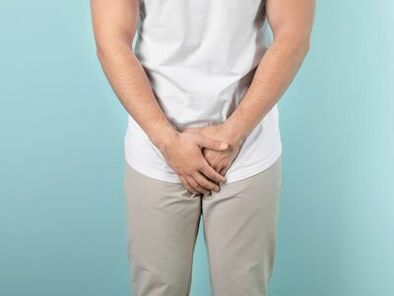
Normally, the male genital organs produce a certain secretion that primarily fulfills a protective function. However, a change in the characteristics and frequency of discharge may be an early sign of the development of a urological disease, such as a sexually transmitted infection, inflammatory or tumor process. Every man should know how to distinguish a physiological secretion from a pathological one. If there are deviations from the norm, you should immediately seek medical help. Below we look at the most common types of urethral discharge in men and their possible causes.
Discharge from the genital organs in men: normal and abnormalities
In men, the secretion of the urogenital organs escapes to the outside via the urethra or urethra. The following variants of physiological discharge in men are possible:
- Urine.Liquid with a yellowish tint and a faint characteristic odor. Normally it is released in portions during controlled micturition. One of the urinary tract diseases is urinary incontinence. In this case, there is either a periodic uncontrolled release of urine in portions of different quantities, or a constant but dropwise release. This symptom indicates a pathology of the urinary system.
- Before cumming.Colorless and odorless mucus secreted during sexual and erotic stimulation (during masturbation, moderate erotic stimulation, during sexual intercourse and before ejaculation). Produced by the paraurethral Cooper's glands. Pre-ejaculate serves as a natural lubricant and deacidifier in the male urethra and female genital tract to increase sperm viability. A deviation from the norm is the release of pre-ejaculate in large quantities.
- Prostate secret.Grey-white opalescent liquid. It is produced by the prostate, is part of the ejaculate and ensures the normal ability of sperm to fertilize. The release of prostate juice outside of ejaculation is called prostatorrhea. Normally, secretion can be released during mechanical impact on the gland (massage) and when straining (during bowel movements). Other forms of prostatorrhea indicate dysfunction of the gland.
- Ejaculate.Grey-white, slimy liquid with a characteristic odor. It has a complex composition. Normally it is released during ejaculation during male orgasm. The release of ejaculate during sexual intercourse and wet dreams (in adolescents and adult men during abstinence) as well as during strong sexual and erotic stimulation is considered physiological. Isolated ejaculations during sleep, as a result of anxiety or physical stress, are not considered a pathology. Any other options for sperm release are a reason to see a doctor.
Men's attention is often attracted by whitish discharge on the head. This is smegma or the secretion of the sebaceous glands. Normally, the secretion is distributed evenly on the head, is washed off during hygiene procedures and does not cause any discomfort. 
If the glands are overactive or if the rules of personal hygiene are violated, the secretion accumulates in the preputial sac (in the foreskin) and becomes clearly visible. Microorganisms can use smegma to reproduce. Therefore, avoiding secretion build-up is an important measure to maintain the health of the sexual organs. If you experience excessive secretion production, you should consult a doctor.
Normal discharge in men should be as described above. Any change in the characteristics, frequency and time of urine, ejaculate or prostate secretion should alert you and be a reason to consult a urologist.
Pathological discharge from the urethra in men
Unusual secretion from the urethra indicates the development of a pathological process in the urogenital tract. Urological diseases in men can manifest themselves in more than just heavy discharge. Scanty secretion, alternating with "clean" periods, is also intended to attract attention. The most common types of pathological discharge in men are as follows:
- Mucus.Abundant mucus secretion is accompanied by inflammatory changes in the urethra. The discharge may be clear, cloudy, or whitish.
- Mucopurulent discharge.Discharge of pus from the urethra indicates an infectious process. A large amount of pathological discharge provokes a feeling of stickiness and discomfort. Sparse – only found in the form of traces on linen.
- White discharge. White mucous discharge in men is accompanied by nonspecific infectious and inflammatory processes. Candidiasis is usually accompanied by a thick, cheesy discharge.
- Gray secret.Gray fluid or mucous discharge may be semen or prostatic secretions flowing outside of physiological conditions. However, it is better to consult a specialist to rule out pathology.
- Damn problems.Brown or pink urine, scarlet or clear mucus streaked with blood, as well as the appearance of blood in semen are signs of structural changes in the urogenital organs, which can be caused by injury, severe inflammation or the development of a neoplasm.
- Foul discharge.Discharge with an unpleasant odor is characteristic of genital infections. A specific foul or putrid odor emanating from the genitals should be a reason to seek medical attention immediately.
Over time, even without treatment, a man may notice a change in the nature and volume of pathological discharge. In some cases, secretion stops, giving the appearance of recovery. However, this is often associated with the development of a chronic pathological process and its transition to an indolent form. After a while, a man may experience pathological discharge from the urethra again. The chronic course of diseases of the urogenital tract is fraught with the development of serious complications (impotence, infertility, etc. ).
What other symptoms could occur?
Diseases of the genitourinary system in men are rarely expressed exclusively in discharge that does not correspond to the norm. Other symptoms also require attention, as conclusions can be drawn about the localization of the pathological process. A man may be worried about the following deviations:
- dysuric disorders (frequent urge to urinate, difficulty urinating, feeling of incomplete emptying, burning and stinging when urinating);
- Changes in urine parameters (unusual color, odor, foaminess, flaky sediment, etc. );
- pain in the lower abdomen;
- Intoxication syndrome (weakness, drowsiness, apathy, etc. );
- decreased libido;
- erectile dysfunction;
- Problems with ejaculation (premature ejaculation, difficulty achieving orgasm, changes in sperm properties, etc. );
- aching pain in the lower abdomen, perineum or scrotum, etc.

Pathological discharge can occur in both infectious and non-infectious diseases. The following symptoms indicate the infectious nature of the deviations:
- Pain, burning when urinating;
- itching in the groin;
- rash, sores on the genitals;
- unpleasant odor emanating from the genitals;
- decreased libido;
- pelvic pain;
- increased body temperature, drowsiness, weakness, etc.
You should seek help soon after symptoms begin. The earlier the diagnosis is made and the correct treatment is prescribed, the greater the likelihood of a full recovery.
What should a man do if there is discharge from the urethra?
A doctor will help you accurately determine the type of pathological discharge. If you have signs of diseases of the genitourinary tract, you should contact a urologist. The initial reception takes place in the following order:
- Conversation with the patient.The doctor carries out an interview, identifies complaints and takes an anamnesis. Honesty when dealing with a specialist is extremely important in determining further examination tactics.
- Physical examination.The urologist visually assesses the condition of the genital organs and mucous membranes. The digital rectal examination allows you to initially determine the size, structure and sensitivity of the prostate.
- Diagnosis.The urologist takes a swab of the urethra, which is then sent for microscopic examination. Depending on the indications, the patient is prescribed additional laboratory methods (blood tests, urine tests and PCR tests for sexually transmitted infections) and instrumental (ultrasound of the pelvic organs, prostate, etc. ) diagnostics.
Based on the examination results, the doctor makes a final diagnosis and prescribes the appropriate treatment.
Treatment of discharge in men
To eliminate pathological discharge, etiotropic therapy is carried out according to the cause of the existing deviations. Treatment may include:
- Drug therapy with antibacterial, antiviral, antiprotozoal drugs, as well as immunomodulators and anti-inflammatory drugs.
- Physiotherapy is used in the complex treatment of chronic infectious and inflammatory diseases.
- Surgical methods – structural changes, hyperplastic processes and neoplasms are eliminated mainly by minimally invasive operations.
The most common cause of male discharge is sexually transmitted infections. In this case, conservative treatment is carried out. The therapy is carried out on an outpatient basis. The duration of treatment varies from several days to several months (depending on the type and form of the disease). At the end of the treatment, a control laboratory test is carried out.
Prevention of discharge in men
Physiological secretion reflects the normal health status of the male reproductive system. It is not discharge, but diseases of the urogenital tract that need to be prevented. To achieve this goal, urologists recommend the following measures:
- Compliance with personal hygiene rules;
- wearing underwear made from natural fabrics;
- selectivity in choosing sexual partners;
- use of barrier contraceptives during casual sexual intercourse;
- avoiding hypothermia;
- regular physical activity;
- balanced nutrition;
- rejection of bad habits;
- Annual check-ups with a urologist.
With immunodeficiency, the body's sensitivity to representatives of opportunistic microflora increases. Microorganisms that do not normally cause disease can cause the development of a nonspecific infectious-inflammatory process. Therefore, in cases of increased physical or psycho-emotional stress, acclimatization and treatment with drugs that reduce immunity, it is necessary to pay particular attention to preventive measures.
















































































